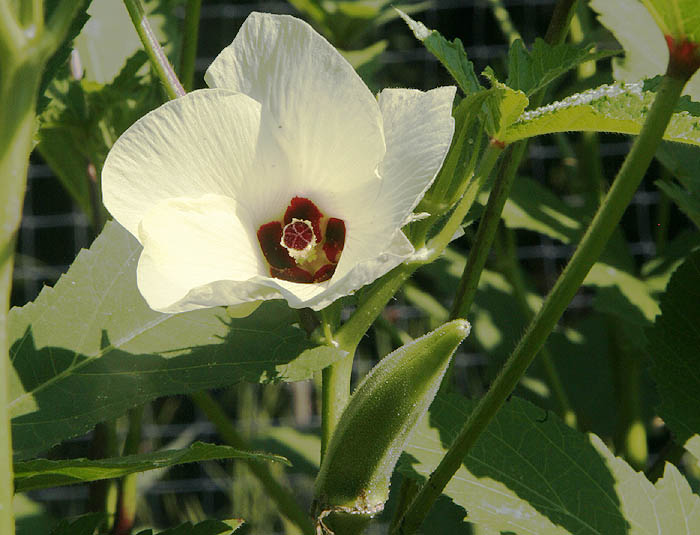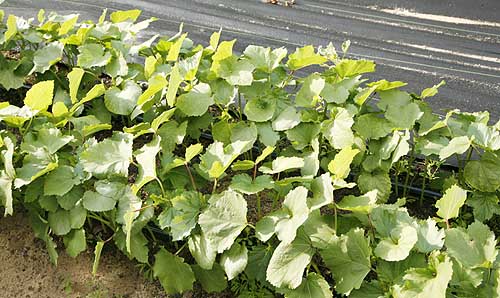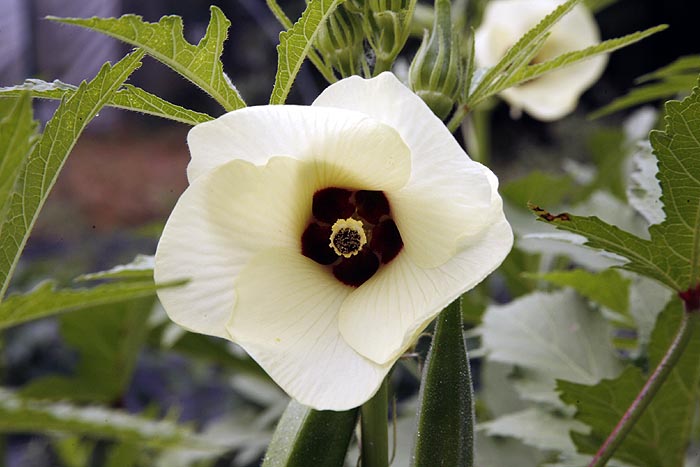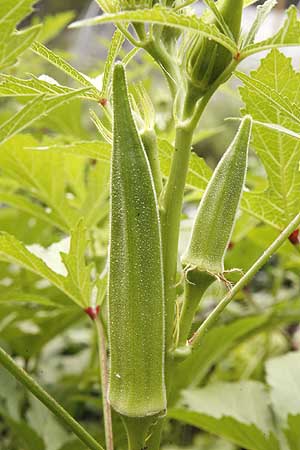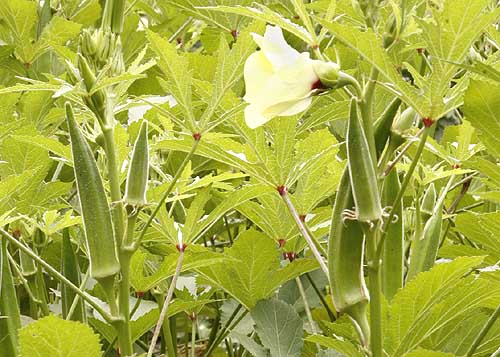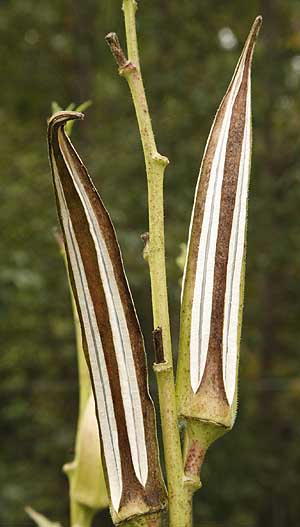Okra is a wonderful versatile vegetable once you know how to cook it properly. Exceedingly easy to grow with little maintenance except harvesting. Grows to about 6 feet in height and has beautiful showy flowers making it worth growing even if you don't want to eat it. The seed pods when ripe are also delightfully showy and stand out from across the garden just like the flowers. Makes a great temporary hedge or wind break. It grows extremely fast and flowers and fruits prolifically. Needs full sun and water to produce at its best. Grow in place does not like to be transplanted.
Description of Okra (Abelmoschus esculentus)
Tall upright annual plant with thick stiff upright stem. Height will depend
on variety ours can reach 6-7 feet in height. Some are as small as 3' while
others grow to 8-9'. Leaves are interesting and can appear very different at
different stages of the plants growth. Very young plants have rounded leaves
with serrated edges, they look more like small saucers. As they mature they
become larger and many lobed sometimes as few as three lobes others as many
as 5. Leaves still have a large surface area and slightly lighter veins often
slightly yellow and serrated edges. As the plants become taller the leaves become
more dramatically lobed with much less leaf area more like that of a Japanese
maple. In all stages the leaves are covered with find spines or bristles that
make them course to touch. In most cases the plants are unbranched, and once
the plants reach 2 feet in height they begin to flower. Flowers are produces
individually at a leaf node near the top of the stem. At this point the plant
will continue to grow taller and produce at flower at each leaf node until late
fall when temperatures fall below 62° F. Flowers are large pale yellow and
immensely showy. Each flower can be up to 3" across consisting of five
large petals arranged in a cone. The center is deep burgundy and holds a large
upright stigma. Each flower only lasts one day then falls off to be replaced
by a seed pod. These are initially green but turn red brown with white stripes
as they mature.
An remarkably attractive plant that is worth growing even if you don't want
to eat the pods.
Location and Care of Okra (Abelmoschus esculentus)
Okra needs lots of full sunshine and a good well drained soil. Since it can
grow to 6' in height choose your location carefully so it does not overshadow
other plants. If possible plant in a North-South direction so other rows will
not be too shadowed by its height - rather than east- west direction where it
will shade rows to the north of it.
For best results add good compost or organic material to the soil before planting.
Run a soaker hose along where the line is going to be and water from the ground.
Okra needs a good deal of water once it begins to crop so watering every day
or every other day for at least 20 minutes is suggested. Fertilizing every week
or so is also recommended as Okra grows extremely fast and is very prolific
in flowering and fruiting.
Ensure that when planting Okra that you use crop rotation, do not plant okra in the same bed year after year, it will not produce a good crop. Also plants can be susceptible to root nematodes, however if crop is rotated and not grown in the same place for at least four years this can be mostly if not completely avoided. Using the space used last year for beans or peas will usually produce the best results.
Best zones and temperatures for Excellent Okra plants and Great Cropping.
Okra will grow well in zone 6 and warmer with ease in colder zones ensure that
it is in the best warm location possible to get the most crop possible. This
is after all a semi tropical plant, and although the amount of warmth it gets
is important
the number of hours of bright daylight are also important.
Overnight temperatures are also extremely important to Okra. If the temperature
drops below 62°F at night even though the plants are flowering well they
will not set pods. This is annoying in zones 6 and warmer where we may have
a few days with lower nighttime temperatures but in colder zones it can make
a lot of difference to crop yields. If you live in a colder zone and still want
to grow okra using a poly house, greenhouse or high tunnel is the best recommendation
for high crops. Under such conditions manual pollination may be necessary.
In warmer zones okra can be sown in early spring for a first crop with a second sowing in June for a later crop if desired.
Growing of Okra (Abelmoschus esculentus) from Seed.
In most cases direct sowing in the ground is the best method. Okra has a delicate
taproot that does not take well to transplanting. Do not plant until soil has
warmed up to at least 65°F or seed will not germinate well. Prepare bed
well and remove all weed seeds. Add a good amount of compost or other organic
material and dig in well. Open a line of soil and plant seeds about ¾
-1" deep. We like to use a hoe to open the row, plant the seeds and cover
again. Sow seeds about 4" apart or in groups of two. Rows should be at
least 3' apart unless growing in double rows with wider areas between. Then
plants can be spaced at 1" apart with 4' each side of the double row. (see
photos of our fields). Many sites suggest thinning plants to 18-24" apart.
This will indeed give you larger stronger plants that many produce a few more
pods. Our choice is to sow more thickly with a spacing of about 8" and
to feed the plants more often. This produces a thick canopy of leaves that shade
out weeds and reduce the need for weeding.
Lay a soaker hose next to the line of seeds and water daily until seeds have
germinated. Okra germinates very rapidly and grows very fast especially if it
has good watering and good soil.
In colder areas plants can be started in individual pots indoors about 2 weeks before last frost date. Harden off well and introduce to full sun gradually before planting out. Take added care when transplanting as okra have sensitive taproots that do not like being disturbed. Ensure that the plant is removed with the whole soil ball from the pot and transplanted whole, or use peat pots and plant directly. If the roots are disturbed plants will be stunted and not grow well.
How much okra to grow?
Since okra only produces one or at the most two pods per plant at a time you
need to grow a fair amount of it just to get enough for one meal. While okra
can be stored in the refrigerator for a few days it does not last well. Therefore
you need to plant more okra than you think you will need. IF possible figure
out how many pods you will need for a family meal and plant half as many plants
again as pod number. Extra can always be frozen for later use.
Harvesting of Okra (Abelmoschus esculentus).
Pods. Once Okra starts to flower it forms
pods remarkably quickly. In zone 6b once the flower has dropped the pod from
that flower will be ready in 2 days. Plants produce pods at a very rapid rate
and harvesting will need to be done every other day in the heat of the summer
or pods will become too tough and inedible.
We recommend that you wear a long sleeved shirt and wear gloves when harvesting okra as the spines can be very irritating and annoying even after the harvest has been completed. Use snips to remove each pod do not try and twist the pod from the plant it will damage it and prevent further flower development. Although plants are considered as 'spineless' this means that there are not large spines on the pods, it does not mean that there are no small spines of the plants themselves.
In warmer zones harvesting begins as soon as the plants reach about 2 feet in height when they begin to flower. Harvesting continues until late fall just before frost (in zone 6b). It goes from bending over and getting backache to reaching up and thinking you might need a stepladder.
Flowers. Some people like to eat the flowers.
Pick these as they open during the mid day hours. Take care that there are no
bees in them before you pick them.
Leaves. Are very nutritious and can also
be eaten. Pick young fresh leaves which have less spines than the older tougher
leaves. Don't take more than a few per plant to allow it to continue growing.
How to check if an okra pod is harvestable.
Obviously small pods or 'minis' are easy. Some people like them when they are
still in the tiny nub stage. For slightly larger pods gently grab the thin tip
of the pod and try to bend it. If it is still pliable then the pod is good to
eat. If the tip will not bend you are too late and its too tough and inedible.
At this stage you can either cut the pod off the plant and discard it or leave
it to form seeds. Leaving too many pods on one plant to produce seed will reduce
flower production as the plant will put its energy into seeds rather than more
pods so we don't recommend more than one or two pods left on the plant.
Storing Okra.
First, don't wash it! Washing it makes it slimy and its impossible to store.
Take straight from the field and place in bags in plastic bags in the refrigerator.
Okra can be stored this way for a few days only. It does not keep and goes moldy
quickly.
If wanted for longer term use it can be chopped up and frozen. We prefer to
open freeze on trays and then bag up for easy access. Don't try and blanch okra
it just gets slimy freeze directly and use in a few months. If desired it can
be frozen as whole pods. Okra can also be dried for longer storage and use,
again don't blanch it first.
Edible Uses of Okra (Abelmoschus esculentus).
A lot of people don't like okra because has a lot of mucilage. Actually this
is one of its good properties and its very good for the stomach and digestive
system. Its just a case of finding the preferred way to cook it. Our best choice
is to chop it up and stir fry it along with other vegetables. This way it does
not get slimy and works as an excellent vegetable with almost any meat. Second
choice is chopped up and deep fried. Battered and deep fried is heavenly.
Don't try to boil or steam it, you wont like the result. It is however an excellent
choice to add to soups and stews as the mucilage helps to thicken the mix and
how can anyone make gumbo without okra.
Okra is very popular in Indian cookery where the whole pods are used.
Okra is very nutritious being rich in pectin, iron and calcium as well as vitamin
A.
Seed is also used ground up to make meal used in making bread or made into
'tofu' or 'tempeh'. The seeds can also be roasted, ground and used as a coffee
substitute. Many sources say this is the best substitute they have found but
it can induce sweating.
Leaves are unusually nutritious and can be cooked like spinach, added to soups
etc or dried for adding to any dish. Washing well before cooking removes the
tiny hairs and makes the leaves enjoyably palatable. Some say the roots are
edible but I would disagree unless you like chewing cardboard.
Medical uses of Okra (Abelmoschus esculentus).
The mucilaginous properties of okra are extremely useful in treating digestive
disorders. It helps calm the digestive system and encourage it to heal. In most
cases eating okra on a daily basis can be exceptionally beneficial. (try stir
fry for most palatable results). Ground okra can also be used in capsules or
compressed into tablets. In some cases the pods are used in others the seeds.
All these can are also used to treat catarrhal infections, ardor urinae, dysuria
and gonorrhoea.
The roots are also used extensively as they have a strong demulcent action and
some claim they are more effective than marsh mallow (Althaea officinalis)
and certainly easier to grow and harvest. Roots need to be fresh and fairly
young. Okra mucilage has been used as a plasma replacement or blood volume expander.
The root juice can be used to treat cuts, boils and wounds. The leaves can be
used as a poultice for similar reasons.
Other uses of Okra (Abelmoschus esculentus)
The severely fiberous stems have long been used for making fiber similar to
jute and used in ropes and course fabrics. It can also be used in paper making.
The mucilage can be used to glaze paper and is added to confectionary. Seed
pods make delightfully attractive additions to dried flower displays.
Other names.
Common okra, okra, okro, lady's fingers, ladies fingers, Gombo, commun, gombo,
gumbo, Quiabeiro, Mbamia,
Synonyms
Hibiscus esculentus.






